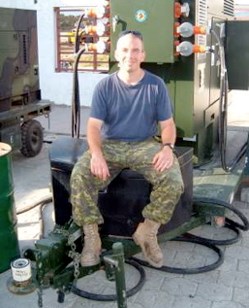The following article about a local soldier helping to rebuild Haiti was submitted to SooToday.com by the public affairs people at Canadian Forces.
The submission has been edited to conform with SooToday.com standards.
Following the story is a link to a BayToday.ca article about another Canadian solider with Sault roots who's also helping Haitians to recover.
************************* Warrant Officer Bob Gray of Sault Ste. Marie was posted to 86 Airfield Systems and Utilities in Trenton as the base's electrical generating systems supervisor when the Haiti earthquake struck.
Shortly after the full scope of destruction had become evident, WO Gray [shown] was told to start packing.
On January 21, he was aboard a plane that landed at Jacmel Airfield in Haiti.
"I am the construction engineering section supervisor and work with 11 tradesmen," Gray said. "Together, we are responsible for refrigeration, electrical power generation and distribution, plumbing, carpentry and water/waste water treatment.
"My background is electrical power generation, but being the supervisor means stepping back and letting my tradesmen do their thing. My role is to prioritize the work and try to get materials."
From the outset, challenges have abounded.
"We had very few tools at the start and even less in the way of materials," Gray continued. "It’s not like we could go downtown to Home Depot and pick up whatever we had left behind in Canada or pick up that item we didn’t think we’d need."
But Gray and company were resourceful, using whatever was available, including pallets that carpenters turned into useful items.
"Most of our time was spent unloading the never-ending stream of aircraft, mostly U.S. Navy helicopters, delivering aid. But as material and tools started arriving, and the aid flights were less frequent, we were able to construct a fairly comfortable camp, with gravity-fed showers and electrical distribution throughout most of the camp."
Canadian tradesmen in Haiti are second to none, Gray emphasized.
It's amazing, he said, to see the amount of progress made under difficult conditions and with little material.
"We are also fortunate enough to have access to the partially constructed terminal, which was about 60 percent complete at the time of the quake.
"Our main focus is to keep Jacmel Airport open to allow aid to come in and authorized persons to leave the country via private aircraft or military airlift. The construction engineering section's specific job is to provide suitable living conditions and utilities to keep the airport functioning."
Challenges include the heat, as well as very rocky and hard ground that makes digging difficult.
It was also hard for Gray's wife, Rachel, and their children, Eric, 10, and Madeline, 6, to say good-bye on such short notice, especially since it meant missing the younger child's birthday.
But Gray and his family are in regular contact now.
"Our sigs [signals] guys have managed to get their link going, so we now have seven computers with Internet and 15-minute phone calls every three days home," he said.
In their spare time, tradesmen in Haiti have made wooden toys for children in the orphanages and schools.
Gray explained the benefits of these efforts.
"We heard from people who had worked in the displaced persons camp about kids playing with empty water bottles and we thought that some wooden toys would be something they would like. So we started building them out of scrap lumber and before we knew it we had about 40 or so toys. They started out as just simple wooden cars, but some guys went all out and constructed wooden planes and helicopters. The kids really like them."
With things now in "sustainment mode," emphasis is on making airport improvements and helping the Haitians run the airport.
From a construction engineering standpoint, that means repairing and repainting the original terminal, installing security fencing, adding a new airport sign and flagpole, and constructing a new gravel parking lot.
"Most of the work is carried out by local workers, who will be paid a comparable wage, and supervised by us," Gray concluded.
************************* Capt. Cory Fryia of Sault Ste. Marie in Haiti To read about another locally connected solider in Haiti, click here.
